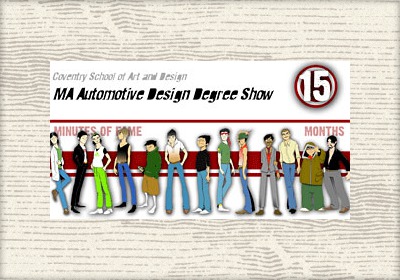College Exhibition: Coventry University MA Degree Show 2005
Fri, 20 Jan 2006 Jan 20, 2006 - 'Fifteen' was the title for Coventry University's 13th MA Design Degree Show, held at Coventry's Transport Museum December 2-9. The title signified a recurring theme: 15 Automotive Design students, 15 months programme duration for the first time, "15 minutes of fame".Graduates from the USA, India, China, Korea, Greece, Lebanon and the UK, made for a strong international flavour in the diversity of the final designs.
2005 was sponsor Corus' ninth year of involvement with the show, and the fifth year they have held a forum to coincide with the opening of the event. A question and answer session chaired by Edmund King, executive director of the RAC Foundation, saw a panel of industry experts examine a number of issues facing the automotive industry, including alternative energy sources, and the use of various materials in car design and manufacture.
The show itself was judged by David Godber, General Manager, Nissan Design Europe; Gerry McGovern, Director of Advanced Design for Land Rover; Roger Bishop, Editorial Director, European Automotive Design; Jon King, Director, Corus Automotive; and last year's winner, Charles Dury, now of Seymour Powell. Between them they picked the top three projects.
The winning design was Jean-Michel Raad's MOOV concept. This was an urban motorbike transportation concept, heavily influenced by Raad's passion for the French discipline of Parcour (or 'free-running'). The vehicle's use of 'biomechanical muscles' allows it to change its chassis configuration permitting the rider to advance over most conceivable urban objects. Raad chose to present his design in virtual form only, using a short animation instead of a traditional static model to demonstrate the dynamicism of the concept. This film showcased not only the concept's capabilities - carefully crafted in Alias 3D animation - but also those of its designer, as Raad himself is seen partaking in free-running exercises. The judges commented on how the MOOV was 'pure passion, innovation, and fantastic execution' and 'the personification of an individual, supported by a tremendous presentation.'
Second place went to the Future New York City Taxi concept by Christopher Lavelanet. Three-box in the most literal sense of the term, the 'Future Taxi' had the central passenger compartment given the greatest priority, with a 'trunk' behind the passenger compartment (between the rear wheels) and the driver, pod-forward, out front. Bringing the familiar Manhattan taxi into the 21st century, Lavelanet's concept relies on in-wheel electric motors for power, to maximise the occupancy area. Influenced by the horse-drawn carriage, the design focuses on passenger space to inspire a luxurious feel.
Alexis Julian Waterson's MiCity compact took third place honours. Intended to placate the current obsession with SUVs, the 'visible structure' promotes feelings of safety in today's hectic urban environment. This diminutive city car concept was at once praised for being - designed from the inside out - and for successfully integrating a 2+1 passenger compartment into this category of diminutive vehicle. Waterson was one of many looking to alternative forms of propulsion in order to maximise the potential of form and design.
Robert Battam's Shorerunner is a beach-buggy update, and looked like a modern interpretation of a 1970s Baja-bug. It engages environmental concerns over pollution, proposing hydrogen as its power source - as well as the inspiration behind its design. With water being the major by-product of hydrogen power, the smooth pebble-like curve of the vehicle's exterior echoes the forms that water creates. A combination of the playful and the rational, the Shorerunner explores less serious applications of environmentally friendly technology, and charts an alternative path for the future of 4x4 design.
By

